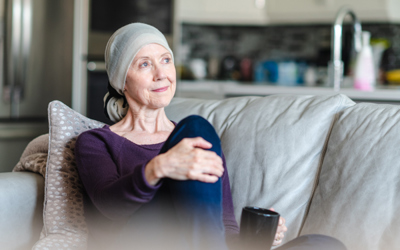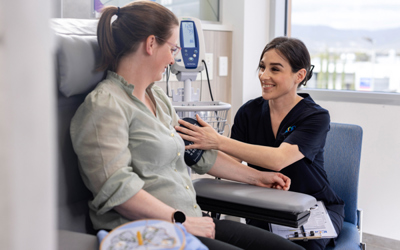What are the treatment options for prostate cancer?
The most common treatment options for prostate cancer include watchful waiting, active surveillance, surgery, radiotherapy and hormone therapy, however other treatments such as chemotherapy, cryotherapy and theranostics are also used. The type of treatment you receive will depend on several different considerations, such as the type of prostate cancer you have, its stage, your overall health and your treatment preferences. This page aims to give you a comprehensive overview of how prostate cancer treatment works.

Watchful waiting for prostate cancer
Watchful waiting is an option for men with small, early-stage prostate cancer which is slow-growing and isn’t causing symptoms. It is typically used for older people who are diagnosed with prostate cancer which isn’t expected to require treatment during their lifetime or for men with serious pre-existing health conditions. In some cases, it may also be offered as an alternative to active cancer treatments such as surgery or radiotherapy. Watchful waiting involves monitoring the prostate cancer through regular PSA tests, with treatment only occurring if the cancer progresses to help manage symptoms.
Active surveillance for prostate cancer
Active surveillance focuses on avoiding or delaying progression to active cancer treatment by monitoring the growth and spread of low-risk prostate cancer which isn’t causing symptoms. It typically involves additional tests to monitor the prostate cancer compared to watchful waiting, including PSA tests, digital rectal exams, MRI scans and biopsies. If the results show that your prostate cancer has begun growing and spreading, active treatment may be recommended.
Surgery for prostate cancer
Surgery is the main treatment for prostate cancer that has not spread beyond the prostate. This commonly involves a radical prostatectomy (removal of the entire prostate, part of the urethra and seminal vesicles).
The three main approaches for prostatectomy, performed under general anaesthesia, include:
-
Open prostatectomy
An open prostatectomy is a procedure where a long incision is made through the skin and abdominal wall or perineum to access your prostate.
-
Laparoscopic prostatectomy
A minimally invasive procedure that uses several small incisions to access the prostate. Laparoscopic procedures result in less postoperative pain and complications, shorter hospital stay and faster recovery compared to open prostatectomy.
-
Robotic-assisted prostatectomy
This procedure uses a robotic system to perform laparoscopic prostatectomy remotely, allowing greater precision in comparison to standard laparoscopic surgery.
During surgery, surrounding lymph nodes may also be removed in a procedure known as a pelvic lymph node dissection. They will then be analysed for the presence of prostate cancer under a microscope to detect if your cancer has spread from the prostate.
Radiotherapy for prostate cancer
Radiotherapy treatment is often used in men with early prostate cancer that hasn’t spread, although it can also be used in combination with other treatments or if your cancer has returned. Radiotherapy may be combined with hormone therapy for high-risk prostate cancers and some unfavourable intermediate risk prostate cancers.
As you may have the option between surgery and radiotherapy treatment, it’s important to talk with your urologist and your radiation oncologist to help you weigh up the advantages and disadvantages of different treatment options and possible side effects like incontinence and erectile dysfunction, availability and cost to help you make an informed decision about the best treatment for you.
There are many different radiation therapy techniques that may be suitable for your prostate cancer.
External beam radiotherapy
External beam radiotherapy (EBRT) is used to treat prostate cancer by delivering highly targeted radiation therapy beams directly to your prostate cancer.
Types of EBRT which can be used for the treatment of prostate cancer include:
Image guided radiation therapy (IGRT) is used to ensure EBRT is delivered as accurately as possible to your prostate cancer. This involves the use of advanced imaging equipment and computer software such as MRI, CT and x-ray.
Ensuring your radiotherapy treatment is highly accurate
As part of your external beam radiation therapy treatment, you may have Calypso® radiofrequency transponders surgically placed in your prostate tumours to track and adjust the radiation beams due to natural movements of the body, such as breathing. Fiducial markers (gold seeds) may also be used, which help to more accurately locate the prostate gland during your treatment.
If your treatment is being delivered using the Varian TrueBeam linear accelerator (therapy machine), triggered imaging technology may be used. This helps identify that a tumour is being accurately and precisely targeted by radiation and is specifically used for prostate cancers. Using markers implanted in the prostate, radiotherapists can visualise your tumour throughout treatment using low dose x-ray images, which allow the machine to automatically detect the position of the markers.
Reducing your risk of side effects
Your doctor may talk to you about having a prostate spacer such as SpaceOAR Hydrogel implanted by a urologist ahead of your treatment. A prostate spacer is a gel-like substance that is implanted between the prostate and rectum to reduce side effects during radiation treatment.
Stereotactic radiotherapy
Stereotactic radiotherapy is an advanced technique used to treat small tumours with well-defined edges and can be used for both primary and metastatic (advanced) prostate cancer. Stereotactic radiation therapy reduces the overall treatment time for prostate cancer to one and a half weeks, delivering high doses of radiation in less than 15 minutes, and monitors the patient’s prostate motion using small gold markers to ensure the radiation is delivered accurately.
Stereotactic radiation therapy for primary prostate cancer is available at Icon Cancer Centres in Cairns, Cairns (Liv Plummer), Canberra, Concord, Epworth Freemasons, Epworth Richmond, Geelong, Gold Coast Private, Gold Coast University Hospital, Gosford, Greenslopes, Hobart, Holmesglen, Mackay, Maitland, Maroochydore, Midland, Mildura, Moreland, Mulgrave, Noarlunga, North Lakes, Norwest, Redland, Revesby, Rockingham, Springfield, Toowoomba and Wahroonga.
Stereotactic radiotherapy can also be used to treat advanced prostate cancer where the disease has started to spread to other parts of the body. Traditionally patients would be treated with hormone therapy and chemotherapy, which are often associated with negative side effects. Icon Group’s TRANSFORM study, published in the International Journal of Cancer, found that stereotactic radiotherapy can delay progression to these treatments for more than two years.
Icon is proud to offer access to this treatment approach at centres in New South Wales, ACT, Queensland, Victoria, Tasmania and Western Australia. If you would like to enquire about stereotactic radiotherapy treatment, please contact your local Icon team or send us a message.
Seed brachytherapy
Brachytherapy is a special form of internal radiotherapy where radioactive seeds are placed in the prostate to treat your cancer. Focal brachytherapy uses the same technique; however, the radioactive seeds are placed into the tumour to directly target your cancer instead of the whole prostate, preserving the rest of the prostate gland and reducing side effects.
Men with prostate cancer can now access new precision focal brachytherapy at Icon Cancer Centre through the LIBERATE clinical registry, which aims to support the use of this cutting-edge prostate cancer treatment and reduce side effects to preserve men’s quality of life. As part of the LIBERATE clinical registry, focal brachytherapy treatment is available at select Icon clinics in Western Australia and Victoria.
Hormone therapy for prostate cancer
As hormones can be a source of fuel for prostate cancer, hormone therapies can be used to block or lower your body’s natural hormones to stop your prostate cancer from growing or returning. Hormone therapy treatment for prostate cancer is also known as Androgen Deprivation Therapy (ADT) and is used to reduce the amount of testosterone in the body. It may be delivered before, during or after other treatments such as radiation therapy or chemotherapy and is commonly given as a tablet or injection.
Common hormone therapy medicines
There are several different types of hormone therapy drugs used to treat prostate cancer.
-
Gonadotrophin-releasing hormone (GnRH) antagonists
These are a group of drugs that work by blocking gonadotrophin hormones which are produced by the pituitary gland within the brain. Gonadotrophin hormones are responsible for controlling the production of testosterone. Blocking them prevents the production and activity of testosterone, stopping the hormones from fueling the growth of prostate cancer cells.
Degarelix – This drug is given by injection under the skin in the abdominal area each month and is used to treat locally advanced or metastatic prostate cancer
-
Gonadotrophin-releasing hormone (GnRH) agonists
leuprorelin, goserelin, buserelin, triptorelin
These drugs work by mimicking the action of the gonadotrophin hormone, which then signals your body to stop the production of testosterone. GnRH agonists are given by injection or as an implant placed under the skin in the abdominal area, arm or buttocks every month to six months. When they are first given, they usually cause a short-term increase in the production of testosterone which is known as a tumour flare. Your doctor may prescribe a course of anti-androgen tablets to prevent this.
-
Anti-androgens
apalutamide, bicalutamide, cyproterone, enzalutamide, flutamide, nilutamide
These drugs are also known as androgen receptor antagonists. They work by attaching themselves to protein receptors on the surface of prostate cancer cells, which prevents testosterone attaching to them and stimulating their growth. They are often used in combination with GnRH agonist drugs and are given orally as tablets or capsules once daily.
Abiraterone – This is a newer type of anti-androgen drug that stops the production of testosterone by the adrenal glands. It is usually given when other anti-androgen drugs have not been effective or are no longer effective. It is taken orally as a tablet once daily and is usually taken together with a steroid drug such as prednisolone to reduce possible side effects
Chemotherapy for prostate cancer
Chemotherapy uses a range of drugs to kill and slow the growth of prostate cancer cells. It may be used to treat prostate cancer which has spread beyond the prostate cancer, and for locally advanced or advanced prostate cancers which have not responded to hormone therapy treatment.
Learn more about chemotherapy and how it is delivered.
Chemotherapy treatment for prostate cancer takes place over several sessions, which is known as a cycle. Your care team will walk you through how many cycles you may need for your course of treatment, with most people completing chemotherapy in a period of three to six months.
Common chemotherapy medicines
There are a number of different chemotherapy drugs that are used to treat prostate cancer.
-
Docetaxel
Docetaxel works by interfering with cellular functions that are performed by structures on cells known as the microtubular network, so that prostate cancer cells are unable to multiply, causing them to die. It is used in the treatment of metastatic prostate cancer (where the cancer has spread outside the prostate gland) and may be given in conjunction with anti-androgen therapy. It is given by intravenous infusion every two to three weeks, usually over six cycles, with each infusion taking around an hour
-
Cabazitaxel
This drug works in the same way as docetaxel. It is used in the treatment of metastatic prostate cancer and is only given if treatment with docetaxel is not effective. It is usually given by intravenous infusion every three weeks, with each infusion taking around one hour.
Cryotherapy for prostate cancer
Cryotherapy (also known as cryosurgery or cryoablation) is a less common treatment for prostate cancer which uses a needle-thin probe and low temperature gases to destroy prostate cancer tumours by freezing them. It may be used if your prostate cancer has come back following radiotherapy treatment, or as an alternative to surgery or radiotherapy for men with low-risk, early-stage prostate cancer.
Theranostics for prostate cancer
Theranostics is a personalised cancer treatment which combines diagnostic imaging to identify a person’s cancer cells and targeted therapy to treat their cancer with radioactive drugs. If standard treatments for advanced prostate cancer have not worked as well as expected or are unsuitable, a type of treatment known as Lutetium-177 Prostate Specific Membrane Antigen (Lu-177 PSMA) therapy may be considered.
PSMA is a type of protein found on the surface of prostate cancer cells – even cells have spread to other areas of the body. In Lu-177 PSMA therapy, a radioactive drug called a radiopharmaceutical is injected into the bloodstream. The drug attaches to the PSMA proteins on prostate cancer cells and delivers targeted radiation to injure or kill them.
Lu-177 PSMA therapy aims to relieve symptoms, maintain or improve quality of life, and potentially slow the growth and spread of cancer.
Clinical trials for prostate cancer
Icon offers a wide-range of clinical trials providing patients with access to new and evolving treatments. Clinical trials offer hope and opportunity and contribute to breakthroughs in treatment for future cancer patients.

Treatment by stage of prostate cancer
When you are diagnosed with prostate cancer, your oncologist will develop your treatment plan as part of a multidisciplinary team based on the stage of your cancer.
Common treatment options for each stage of prostate cancer include:
Localised prostate cancer (Stage I and II)
Surgery to remove the prostate gland (radical prostatectomy), radiotherapy with or without hormone therapy and active surveillance are the most common treatment options for early-stage prostate cancer, alongside cryotherapy. Radiotherapy may involve external beam radiotherapy or brachytherapy. With recent advances in prostate cancer treatment, you may also have the option of focal brachytherapy treatment.
Locally advanced prostate cancer (Stage III)
Locally advanced prostate cancer requires a combination of treatments, which usually begins with radiotherapy combined with hormone therapy or surgery. If you receive surgery, radiotherapy is often recommended as your second line of treatment.
Metastatic or advanced prostate cancer (Stage IV)
Treatment for stage IV prostate cancer commonly includes hormone therapy, which may be delivered in combination with chemotherapy. If hormone therapy is no longer effective, further treatments may include chemotherapy, immunotherapy, or targeted therapy or theranostics. Clinical trials may also offer new treatment options for advanced prostate cancer patients.













